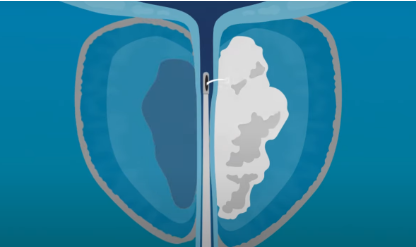By: Thalia Kaylyn Averil
Benign Prostatic Hyperplasia (BPH) is a common condition in urology which is characterized by a gradual increase in the size of the prostate gland over time. This disease mainly affects elderly men, about 40% of those aged around 50 years and up to 90% of those aged over 90 years experience BPH. In most patients with benign prostatic hyperplasia, prostate enlargement causes obstruction of the flow of urine from the bladder, causing symptoms of difficulty urinating. These symptoms can have a significant impact on quality of life, which tends to worsen as the prostate enlarges.
Treatment for symptoms caused by bladder obstruction due to BPH involves various methods, including conservative measures such as monitoring and lifestyle changes, medications, or surgery. However, treatment using medications can cause several side effects, such as orthostatic low blood pressure (changes in blood pressure due to changes in position) and sexual problems. Surgery is often the most effective treatment, with options such as Holmium Laser Enucleation of the Prostate (HoLEP) and prostate artery embolization. Transurethral Resection of the Prostate (TURP) of the prostate is the most commonly performed surgical procedure, but it still has disadvantages, including a high rate of complications following the procedure. To address these issues, minimally invasive procedures such as the Rezum system have been developed, aiming to offer an alternative surgical option to TURP with fewer risks.
Currently, water vapor therapy has been developed as an alternative treatment for benign prostatic hyperplasia without the side effects of drugs or complications from surgery. Rezum Water Vapor Therapy is a non-surgical procedure that uses steam therapy to remove prostate tissue pressing on the urethra (the tube that carries urine out of the bladder). This technology utilizes the thermodynamic properties of water, where radiofrequency current is applied to an inductive coil heater, producing thermal energy in the form of steam. The sterile steam is then released into the prostate tissue for approximately 9 seconds. When it comes into contact with body tissue temperature, water vapor will condensate. These changes can cause energy to be released into prostate tissue, causing necrosis or cell death.
Rezum Water Vapor Therapy has several advantages, one of which is the prolonged relief of urinary tract-related symptoms. This is marked by improvements in the questionnaire regarding the severity of benign prostatic hyperplasia symptoms, urine flow rate, and post-void residual volume. One of the side effects that concerns patients undergoing conventional treatments, such as Transurethral Resection of the Prostate (TURP) or medications, is the adverse impact on erectile and ejaculatory function as well as a decrease in libido. However, therapy with Rezum Water Vapor Therapy can maintain sexual function in sexually active men, allowing patients to feel more confident and satisfied with this therapy. Therefore, patients’ quality of life can also improve with this therapy compared to other conventional treatments. Sexual function can be preserved because the mechanism of Rezum Water Vapor Therapy does not remove any anatomically important parts of the prostate. This is also the reason for the reduced risk of complications related to urinary incontinence with this therapy.

Figure 1. Rezum Water Vapor Therapy procedure.
The number of treatments required varies based on the size of the prostate. Over time, the prostate will shrink due to the body’s natural healing process, which absorbs the extra prostate tissue. This results in a more open urethra, thereby reducing the symptoms caused by benign prostatic hyperplasia. Patient responses to water vapor therapy can vary, but most patients feel their symptoms decrease within two weeks and maximum benefits are obtained within three months.
The following are several things that will be done before, during, and after the Rezum Water Vapor Therapy procedure.
- Before the procedure
Your healthcare professional may ask you to stop taking anticoagulants or blood thinners a week before the procedure. Additionally, you may be prescribed antibiotics and invited to discuss the pain medication that will be used later.
- During the procedure
This procedure only takes a few minutes, but it’s advisable to allow about two hours for it. You will also receive the pain medication that has been discussed earlier. However, it is not recommended to drive yourself home afterwards, unless your healthcare provider has allowed it.
- After the procedure
After the procedure, you will be asked to continue taking the prescribed antibiotics. For several days, your healthcare provider may suggest using a catheter to help with urination during the healing process. You should also avoid activities that can worsen your prostate condition. If you feel uncomfortable, you can try taking pain medication, bathing in warm water, or avoiding caffeine, chocolate, and alcohol consumption.

Figure 2. Rezum Water Vapor Therapy device.
Resources
- Westwood J, Geraghty R, Jones P, Rai BP, Somani BK. Rezum: a new transurethral water vapour therapy for benign prostatic hyperplasia. Ther Adv Urol. 2018 Aug 12;10(11):327-333. doi: 10.1177/1756287218793084. PMID: 30344644; PMCID: PMC6180381. Available from: https://www.ncbi.nlm.nih.gov/pmc/articles/PMC6180381/
- Boston Scientific. Rezum water vapor therapy [Internet]. Massachusetts: Boston Scientific; date of publication unknown [cited 2024 May 12]. Available from: https://www.rezum.com/what-is-rezum/how-does-it-work.html
- McVary KT, Rogers T, Mahon J, Gupta NK. Is Sexual Function Better Preserved After Water Vapor Thermal Therapy or Medical Therapy for Lower Urinary Tract Symptoms due to Benign Prostatic Hyperplasia? J Sex Med. 2018 Dec;15(12):1728-1738. doi: 10.1016/j.jsxm.2018.10.006. Epub 2018 Nov 13. PMID: 30446471. Available from: https://pubmed.ncbi.nlm.nih.gov/30446471/
